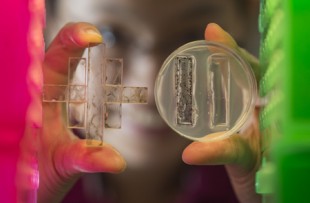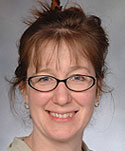MEDIA CONTACTS:
David Ruth
713-348-6327
david@rice.edu
Jade Boyd
713-348-6778
jadeboyd@rice.edu
Biochar quiets microbes, including some plant pathogens
Synthetic biologists at Rice probe biochar’s impact on microbial signaling
HOUSTON — (Sept. 30, 2013) — In the first study of its kind, Rice University scientists have used synthetic biology to study how a popular soil amendment called “biochar” can interfere with the chemical signals that some microbes use to communicate. The class of compounds studied includes those used by some plant pathogens to coordinate their attacks.
Biochar is charcoal that is produced — typically from waste wood, manure or leaves — for use as a soil additive. Studies have found biochar can improve both the nutrient- and water-holding properties of soil, but its popularity in recent years also owes to its ability to reduce greenhouse gases by storing carbon in soil, in some cases for many centuries.

Rice University graduate student Shelly Hsiao-Ying Cheng shows the tool she created with Rice biochemist Joff Silberg to conduct two experiments in the same dish, one where biochar had a chance to interfere with a microbial conversation and another where it didn't.
The new study, published online this month in the journal Environmental Science and Technology, is the first to examine how biochar affects the chemical signaling that’s routinely used by soil microorganisms that interact with plants.
“A potted plant may look tranquil, but there are actually a lot of conversations going on in that pot,” said study co-author Joff Silberg, associate professor of biochemistry and cell biology and of bioengineering at Rice. “In fact, there are so many different conversations going on in soil that it was impractical for us to determine exactly how biochar was affecting just one of them.”
So Silberg and colleagues used the tools of synthetic biology — and a refined experimental setup that Silberg initially drafted with his son’s spare Lego bricks — to establish a situation where just one microbial conversation was taking place and where biochar’s effects on that conversation could be measured.
The study is the latest from Rice’s interdisciplinary Biochar Research Group, which formed in the wake of Hurricane Ike in 2008 when the city of Houston called for ideas about how to get rid of the estimated 5.6 million cubic yards of fallen trees, broken branches and dead greenery left behind by the storm. The Rice Biochar Group won the $10,000 grand prize in the city’s “Recycle Ike” contest and used the money to jump-start a wide-ranging research program that has since received support from the National Science Foundation, the Department of Energy, Rice’s Faculty Initiative Fund, Rice’s Shell Center for Sustainability and Rice’s Institute of Bioscience and Bioengineering.
The cell-signaling study grew out of a previous investigation by one of the group’s founding members, Carrie Masiello, associate professor of Earth science. Masiello and another member of the group, Rice biologist Jennifer Rudgers (now at the University of New Mexico), were investigating the combined effects of adding biochar and nutrients to soils. In all but one case, the biochar and nutrients seemed to enhance one another. In the lone exception, a soil fungus that was typically beneficial to plants began growing so rapidly that it impeded plant growth.
“All of these organisms, to a much greater extent than we probably understand, are talking to each other all the time,” Silberg said. “Microbes talk to microbes. Microbes talk to plants. Plants talk to microbes. And they each make decisions about their behavior based on those conversations. When we started talking about these results, my first thought was, ‘You’re probably interfering with a conversation.'”
There was no practical way to isolate the conversation that was likely being interfered with in the previous experiment, but Silberg thought of a way to create engineered microbes to test the idea of whether biochar could interfere with such a conversation.
His lab began by working with Matt Bennett, assistant professor of biochemistry and cell biology at Rice, to make use of two tailored forms of E. coli bacteria created by Rice graduate student Chen Ye. One strain “spoke” with a type of chemical communication commonly used by soil microbes, and the other “listened.” Unlike the fungi that use this communication method in soil, the E. coli could be grown in clear agar gels in a petri dish, which meant the researchers could more easily observe them under a microscope. The team next inserted florescence genes into each organism, which caused them to glow different colors — red for speaking and green for listening.
“We needed a way to conduct two experiments in the same dish, one where biochar had a chance to interfere with a conversation and another where it didn’t,” Silberg said.
Working with his son’s Legos, Silberg constructed a pair of rectangular platforms that sat parallel in the dish, about one inch apart. Agar was added to fill all parts of the dish except for the areas blocked by the bricks. Once the agar gel had set, the rectangular platforms were removed to create two empty parallel troughs. One of these was filled with clear agar, and the other was filled with agar containing biochar. “Speaker” organisms were added to the middle of the dish, and “listeners” were placed on the opposite side of each trough.
Graduate student Shelly Hsiao-Ying Cheng refined Silberg’s Lego design and used tools at Rice’s Oshman Engineering Design Kitchen to create a set of sturdy platforms for repeated tests. The group then ran dozens of microscopy tests with Dan Wagner, Rice associate professor of biochemistry and cell biology, to see how different formulations and amounts of biochar affected cell signaling.
“In every case, we observed significantly less green light from the opposite side of the biochar, which meant the E. coli on that side had trouble hearing the sender,” Silberg said. “That upheld our hypothesis, which was that biochar could interfere with cell signaling, most likely by binding with the fatty-acid molecules that the speakers were using to broadcast their message.”
The team found that biochar that was created with higher temperatures was as much as 10 times more effective at shutting down conversations. The researchers said this finding was significant because it jibed with the results from a 2012 study by Masiello that found that biochars created with higher-temperature processes were more effective at holding water and nutrients.
“Biochar can be made in processes that range from 250 to 1,000 degrees Celsius, and there’s mounting evidence that the temperature can dramatically affect the final properties,” Masiello said. “Ultimately, we’d like to create a simple guide that people can use to tailor the properties of their biochar.”
Silberg added, “Some microbes help plants and others are harmful. That means there’s good communication and bad communication going on in the soil at the same time. We think it’s likely that some biochars will knock out some conversations and not others, so we want to test that idea and, if possible, come up with a way to tailor biochar for the microbial diversity that’s desired.”
Study co-authors include Ye Chen, Xiaodong Gao, Shirley Liu and Kyriacos Zygourakis, all of Rice.
###
High-resolution IMAGES are available for download at:
https://news2.rice.edu/files/2013/09/0930-BIOCHAR-colors-lg.jpg
CAPTION: Rice University graduate student Shelly Hsiao-Ying Cheng shows the tool she created with Rice biochemist Joff Silberg to conduct two experiments in the same dish, one where biochar had a chance to interfere with a microbial conversation and another where it didn’t.
CREDIT: Jeff Fitlow/Rice University
A copy of the Environmental Science and Technology study is available at:
http://pubs.acs.org/doi/abs/10.1021/es401458s
Located on a 300-acre forested campus in Houston, Rice University is consistently ranked among the nation’s top 20 universities by U.S. News & World Report. Rice has highly respected schools of Architecture, Business, Continuing Studies, Engineering, Humanities, Music, Natural Sciences and Social Sciences and is home to the Baker Institute for Public Policy. With 3,708 undergraduates and 2,374 graduate students, Rice’s undergraduate student-to-faculty ratio is 6-to-1. Its residential college system builds close-knit communities and lifelong friendships, just one reason why Rice has been ranked No. 1 for best quality of life multiple times by the Princeton Review and No. 2 for “best value” among private universities by Kiplinger’s Personal Finance. To read “What they’re saying about Rice,” go to http://tinyurl.com/AboutRiceU.



